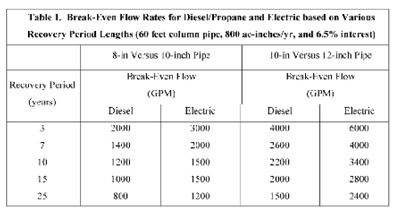Do You Need 12-Inch Column Pipe For YourWells?
PORTAGEVILLE, MO.
For the irrigation world, the old adage “desperate times, call for desperate measures”, might be rephrased to read: “big fuel costs, call for big pipe sizes.” The point being, that with the high flow rates common in the SE Missouri area and today’s price of energy, we need to make sure the column pipe we are installing in our wells is not wasting too much energy from excessive friction loss occurring because the pipe size is too small. Indications show that in some instances we may need to move up to 12-inch column pipe, even if it means drilling a 16-inch well versus a 10- or 12-inch one.
Irrigation wells consist of the outer casing pipe, normally made of PVC, and the inner column pipe, normally made from steel. The water travels up the column pipe, so it is in the column pipe that friction loss occurs. Typically, column pipe size is either 8 or 10 inches. Pumps are typically set at 60 feet, so friction occurs during this brief sojourn to the surface. However, if the pump has an intake pipe on the bottom end, say ten feet long, then friction loss will occur there also, thus friction occurs along 70 feet of pipe in this instance. Obviously, the longer the length of pipe, the more the amount of friction loss will be.

Here is why we may be needing bigger column pipe sizes: as flow rates increase, the friction loss goes up. Actually, friction loss is related to the velocity the water is moving at. For any given flow rate, velocity increases with smaller pipe sizes. Thus, small pipe sizes have more friction loss then do bigger pipe sizes, and therefore gobble up more energy, increasing the cost of the pumped water. At 2000 GPM, a 10-in pipe has twice as much friction loss as a 12-inch pipe has, while an 8-inch pipe has seven times more loss.
Besides the already mentioned factors of pipe diameter and pipe length, the other significant factors impacting the cost of the annual energy lost from friction loss are (1) the cost of fuel and (2) the amount of inches pumped. Since diesel/propane is nearly twice as expensive as electricity, there will be more incentive to go to bigger pipe sizes if you use diesel or propane.
While bigger pipe sizes have less associated operating costs, they obviously are more expensive. In addition, if one moves up to a bigger column pipe size, he also may face extra costs by having to jump a size on the well and casing used so that it will accommodate the larger diameter of column pipe opted for.
“Pay now, or pay later” aptly describes the situation – pay up front for a bigger size, or pay the utility company later for added energy costs. The break-even flow rate is the Gallon per Minute amount at which the combined annual energy costs plus the amortized fixed costs of the pipe are equal between two pipe sizes. If the pump flow rate exceeds the break-even flow rate, then its cheaper to go with the larger sized pipe.
The original cost of a new well is a package deal involving the steel column pipe of a size sufficient for the flow rate, plus the cost of drilling and casing a well that can handle the size of the column pipe chosen. In our region, typical column pipe length is 60 feet, while typical well and casing length is normally about 100 feet. The cost of both of these things is amortized to an annual cost by using the interest rate of the money involved and determining the number of years desired to recovery the investment. Although wells can have a system life of over 25 years, no banker would carry the paper that long, so you might choose a recovery period of 5 to 7 years. As the fiscal recovery period increases, the breakeven decreases. As indicated earlier, the more expensive diesel/propane systems will have bigger breakeven points then electricity. Although the well is 100 feet deep, pipe friction loss will occur in the 60-foot length of column pipe.
Table 1 shows the break-even flow rates between 8- versus 10-inch and 10- versus 12- inch pipe pairs for various return periods and type of fuel used.
In summary, the size of column pipe you choose is based on the flow rate of your well, but other factors to consider include whether you use diesel/propane or electricity. Δ
Dr. Joe Henggeler is Irrigation Specialist with the University of Missouri Delta Center at Portageville.